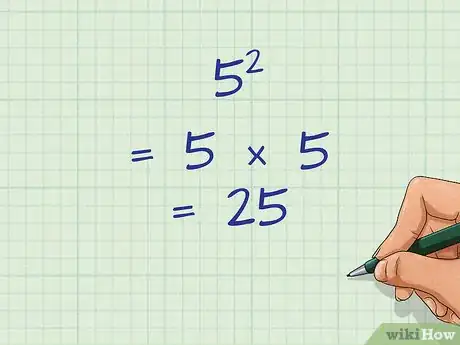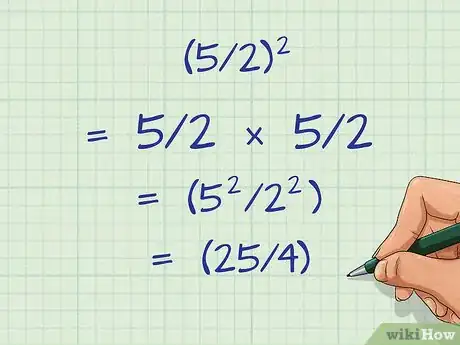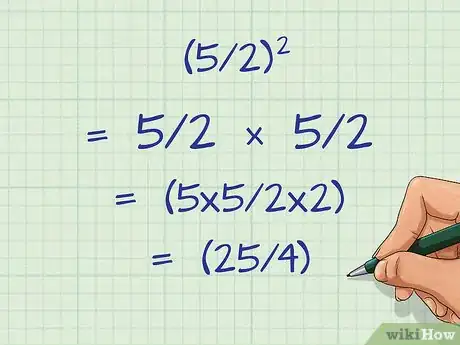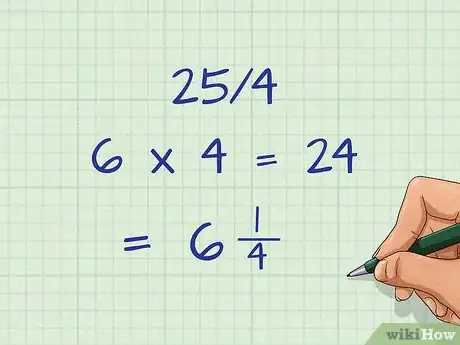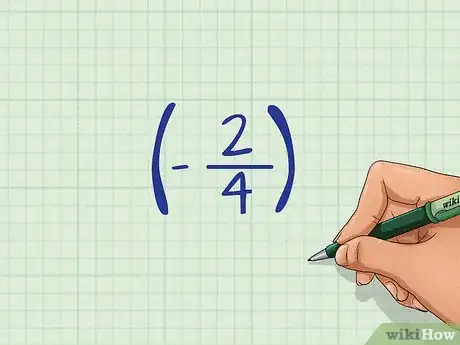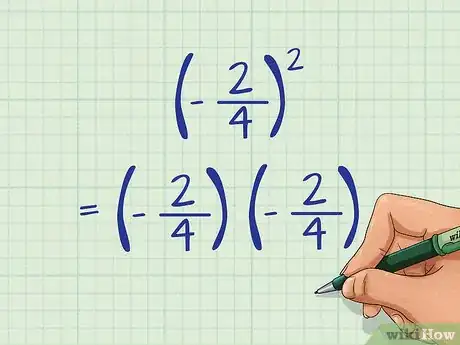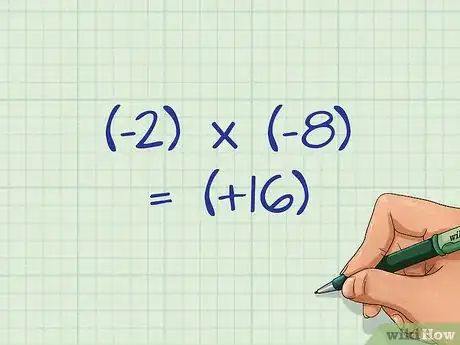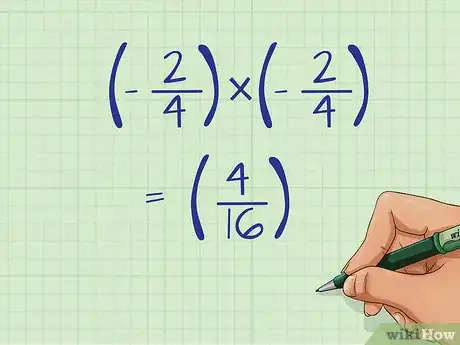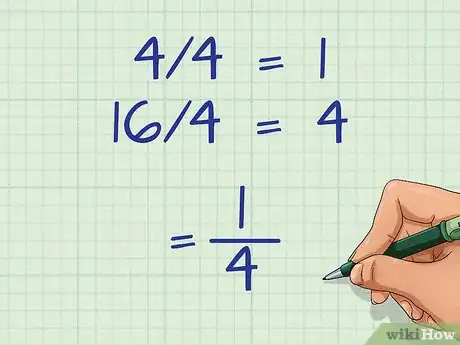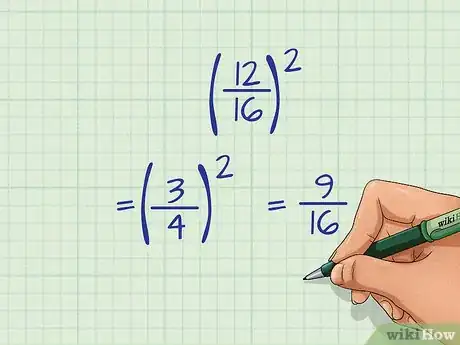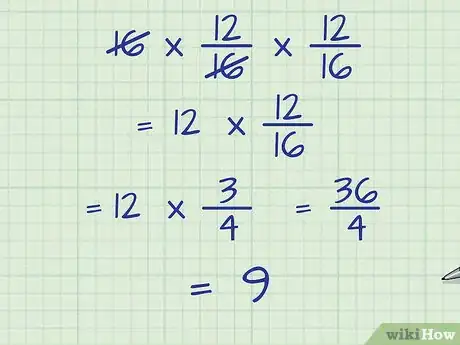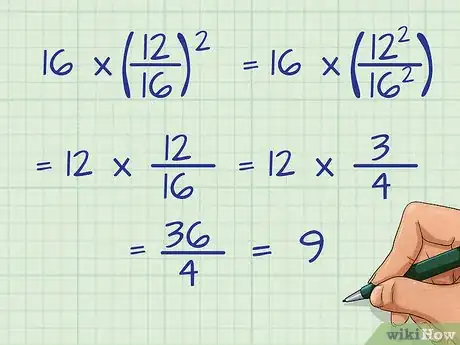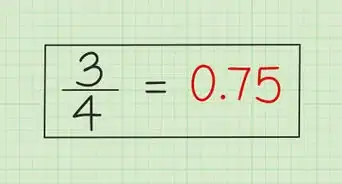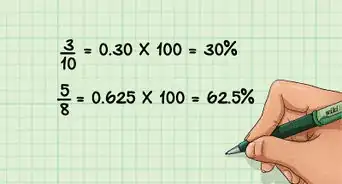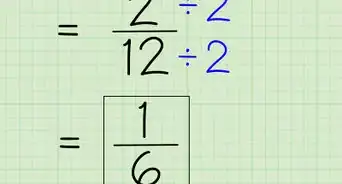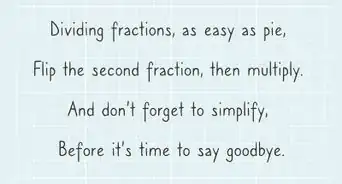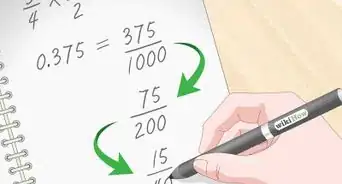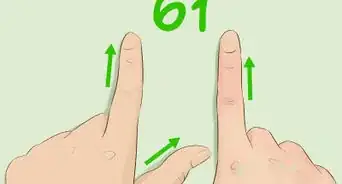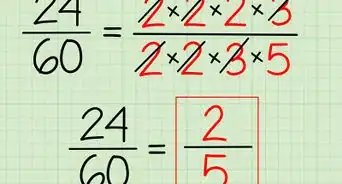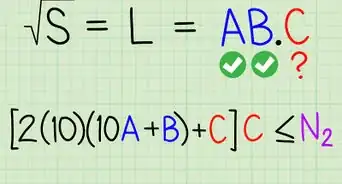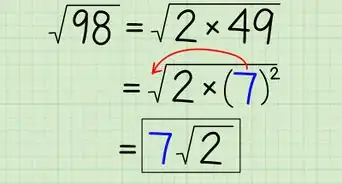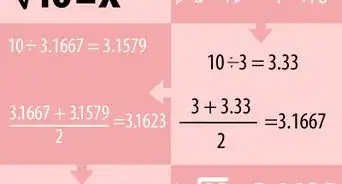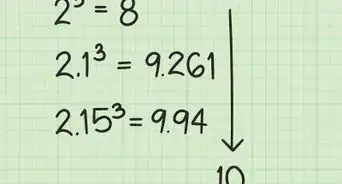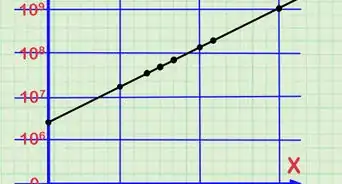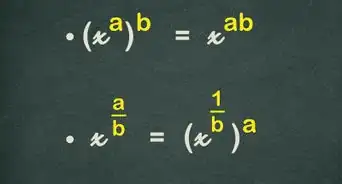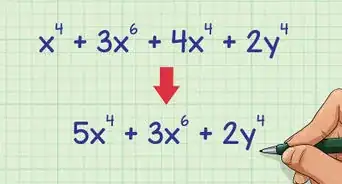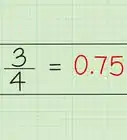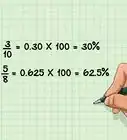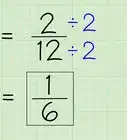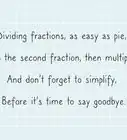This article was co-authored by wikiHow Staff. Our trained team of editors and researchers validate articles for accuracy and comprehensiveness. wikiHow's Content Management Team carefully monitors the work from our editorial staff to ensure that each article is backed by trusted research and meets our high quality standards.
This article has been viewed 818,078 times.
Learn more...
Squaring fractions is one of the simplest operations you can perform on fractions. It is very similar to squaring whole numbers in that you simply multiply both the numerator and the denominator by itself. There are also some instances in which simplifying the fraction before squaring makes the process easier. If you haven't yet learned this skill, this article provides an easy overview that will improve your understanding quickly.
Steps
Squaring Fractions
-
1Understand how to square whole numbers. When you see an exponent of two, you know that you need to square the number. To square a whole number, you multiply it by itself.[1] For example:
- 52 = 5 × 5 = 25
-
2Realize that squaring fractions works the same way. To square a fraction, you multiply the fraction by itself. Another way to think about it is to multiply the numerator by itself and then the denominator by itself.[2] For example:
- (5/2)2 = 5/2 × 5/2 or (52/22).
- Squaring each number yields (25/4).
Advertisement -
3Multiply the numerator by itself and the denominator by itself. The actual order that you multiply these numbers by themselves doesn’t matter as long as you have squared both numbers. To keep things simple, start with the numerator: simply multiply it by itself. Then, multiply the denominator by itself.[3]
- The numerator will stay on top of the fraction and the denominator will stay at the bottom of the fraction.
- For example: (5/2)2 = (5 x 5/2 x 2) = (25/4).
-
4Simplify the fraction to finish. When working with fractions, the last step is always to reduce the fraction to its most simple form or turn the improper fraction into a mixed number.[4] For our example, 25/4 is an improper fraction because the numerator is larger than the denominator.
- To convert to a mixed number, divide 4 into 25. It goes in 6 times (6 x 4 = 24) with 1 leftover. Therefore, the mixed number is 6 1/4.
Squaring Fractions with Negative Numbers
-
1Recognize the negative sign in front of the fraction. If you are working with a negative fraction, it will have a minus sign in front of it. It is good practice to always put parentheses around a negative number so you know that the “–“ sign is referring to the number and not telling you to subtract two numbers.[5]
- For example: (–2/4)
-
2Multiply the fraction by itself. Square the fraction as you would normally by multiplying the numerator by itself and then multiplying the denominator by itself. Alternatively, you can simply multiply the fraction by itself.
- For example: (–2/4)2 = (–2/4) x (–2/4)
-
3Understand that two negative numbers multiply to make a positive number. When a minus sign is present, the entire fraction is negative. When you square the fraction, you are multiplying two negative numbers together. Whenever two negative numbers are multiplied together, they make a positive number.[6]
- For example: (-2) x (-8) = (+16)
-
4Remove the negative sign after squaring. After you have squared the fraction, you will have multiplied two negative numbers together. This means that the squared fraction will be positive. Be sure to write your final answer without the negative sign.[7]
- Continuing the example, the resulting fraction will be a positive number.
- (–2/4) x (–2/4) = (+4/16)
- Generally, the convention is to drop the “+” sign for positive numbers.[8]
-
5Reduce the fraction to its simplest form. The final step when doing any calculations with a fraction is to reduce it. Improper fractions must first be simplified into mixed numbers and then reduced.[9]
- For example: (4/16) has a common factor of four.
- Divide the fraction through by 4: 4/4 = 1, 16/4= 4
- Rewrite simplified fraction: (1/4)
Using Simplifications and Shortcuts
-
1Check to see if you can simplify the fraction before you square it. It is usually easier to reduce fractions before squaring them. Remember, to reduce a fraction means to divide it by a common factor until the number one is the only number that can be evenly divided into both the numerator and denominator.[10] Reducing the fraction first means you don’t have to reduce it at the end when the numbers will be larger.
- For example: (12/16)2
- 12 and 16 can both be divided by 4. 12/4 = 3 and 16/4 = 4; therefore, 12/16 reduces to 3/4.
- Now, you will square the fraction 3/4.
- (3/4)2 = 9/16, which cannot be reduced.
- To prove this, let’s square the original fraction without reducing:
- (12/16)2 = (12 x 12/16 x 16) = (144/256)
- (144/256) has a common factor of 16. Dividing both the numerator and denominator by 16 reduces the fraction to (9/16), the same fraction we got from reducing first.
-
2Learn to recognize when you should wait to reduce a fraction. When working with more complex equations, you may be able to simply cancel one of the factors. In this case, it is actually easier to wait before you reduce the fraction. Adding an additional factor to the above example illustrates this.
- For example: 16 × (12/16)2
- Expand out the square and cross out the common factor of 16:
16* 12/16* 12/16- Because there is one 16 whole number and two 16’s in the denominator, you can cross ONE of them out.
- Rewrite the simplified equation: 12 × 12/16
- Reduce 12/16 by dividing through by 4: 3/4
- Multiply: 12 × 3/4 = 36/4
- Divide: 36/4 = 9
-
3Understand how to use an exponent shortcut. Another way to solve the same example is to simplify the exponent first. The end result is the same, it’s just a different way to solve.
- For example: 16 * (12/16)2
- Rewrite with the numerator and denominator squared: 16 * (122/162)
- Cancel out the exponent in the denominator:
16* 122/162- Imagine the first 16 has an exponent of 1: 161. Using the exponent rule of dividing numbers, you subtract the exponents. 161/162, yields 161-2 = 16-1 or 1/16.
- Now, you are working with: 122/16
- Rewrite and reduce the fraction: 12*12/16 = 12 * 3/4.
- Multiply: 12 × 3/4 = 36/4
- Divide: 36/4 = 9
Community Q&A
-
QuestionHow do I solve 2 (1/3)?
 DonaganTop AnswererMultiply the fraction's numerator by the whole number, and retain the denominator.
DonaganTop AnswererMultiply the fraction's numerator by the whole number, and retain the denominator. -
QuestionHow do I use exponential notation for a fraction raised to a power?
 Community AnswerUse parentheses around the fraction, and ^ to raise it to any power. For example: one third, squared: (1/3)^2.
Community AnswerUse parentheses around the fraction, and ^ to raise it to any power. For example: one third, squared: (1/3)^2. -
QuestionHow do I solve (3/16) divided by [(1/2+1/4)squared]?
 DonaganTop Answerer(½ + ¼)² = (¾)² = 3² / 4² = 9/16. 3/16 divided by 9/16, which is the same as 3/16 multiplied by 16/9, which equals 48/144, which equals 1/3.
DonaganTop Answerer(½ + ¼)² = (¾)² = 3² / 4² = 9/16. 3/16 divided by 9/16, which is the same as 3/16 multiplied by 16/9, which equals 48/144, which equals 1/3.
Things You'll Need
- Paper or screen for working on
- Pencil/Pen (for use w/ paper)
References
- ↑ https://www.mathsisfun.com/square-root.html
- ↑ https://www.wtamu.edu/academic/anns/mps/math/mathlab/int_algebra/int_alg_tut41_rationalize.htm
- ↑ https://www.wtamu.edu/academic/anns/mps/math/mathlab/int_algebra/int_alg_tut41_rationalize.htm
- ↑ https://www.mathsisfun.com/improper-fractions.html
- ↑ https://www.mathsisfun.com/multiplying-negatives.html
- ↑ https://www.mathsisfun.com/multiplying-negatives.html
- ↑ https://www.mathsisfun.com/algebra/exponents-squaring-negative.html
- ↑ https://www.mathsisfun.com/multiplying-negatives.html
- ↑ https://www.mathsisfun.com/simplifying-fractions.html
About This Article
To square a fraction, simplify the fraction as much as you can. Next, multiply the numerator by itself, then multiply the denominator by itself. If you are squaring a negative fraction, the result will be positive. Reduce the fraction to its simplest form. If you want to learn how to simplify your fractions before squaring them, keep reading the article!
